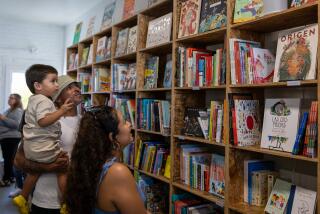EXPERT ADVICE
- Share via
When I was 10 years old, my family emigrated from Peru to Canada. I remember on my first day in Vancouver seeing a billboard that read “Television.”
Although I was a native Spanish speaker, I thought to myself, English couldn’t be that hard if it used Spanish words.
That was the first of many lessons I would gain in how the two languages are similar and how I could use one to learn the other.
Many words are similar in both languages. By recognizing this, I have turned the similarity into a strategy to teach my own son to be bilingual.
Others can use the same strategy. Many common words can be used to teach Spanish-speaking immigrant children and adults vocabulary in English. Immigrant children can use words to help their parents learn English, and parents can use them in turn to teach their children Spanish.
By starting with words that we know in one language and recognizing that they correspond to similar words in a second language, learning is made effortless. We recognize that we already know more than we think.
Here are a few examples of the ways we can use one language to learn another, starting with places we go and things we can do:
* En el zoologico/At the zoo: mono/monkey, pinguino/penguin, tigre/tiger, cebra/zebra, animales/animals.
* En el parque/At the park: beisbol/baseball, bicicleta/bicycle, bola/ball, insecto/insect.
* En el jardin/In the garden: flor/flower, fruta/fruit, limon/lemon, palma/palm, pera/pear, rosa/rose.
We can organize these words by themes on flashcards and learn the second language (Spanish or English) on the bus ride to work or during lunch hour. We can paste cue cards next to items in the house. We can learn with our children wherever we go by having the person who is literate in both languages point out the things that have similar words.
After a while, we can take turns and make a game of it, and expand to other words that aren’t the same. We can also use the same approach with co-workers. This latter strategy works well with individuals who may not be literate in their native language.
There are plenty of other opportunities to take advantage of literacy lessons--in waiting rooms and checkout lines, on the bus or at a bus stop, in the cafeteria or lounge at work.
At the doctor’s office, bilingual signage not only can develop bilingual literacy but also can serve as a form of preventive medicine by making information available to Spanish-speaking patients.
At schools and libraries, children can work on a project to identify common words based on themes, then create an exhibit, book or World Wide Web page and display it for their parents. Literacy and educational organizations can develop advertisements with pictures and Spanish and English words that are alike and request that they be placed as public service announcements on billboards and benches, in magazines and in supermarkets.
In short, the road to bilingual literacy can begin with communication. “Hola” or “Hello” is a good start.
BOOK EVENTS
* Wednesday in La Puente: Read about the skill of painting murals and actually paint one at 2 p.m., the Sunkist Library, 840 N. Puente Ave. (626) 960-2707
* Thursday in Cerritos: Paul Bunyan story time for children at 7 p.m., Barnes & Noble, 12741 Towne Center Drive. (562) 809-5767
* Friday in Sun Valley: Puppet show and storytelling for children at 3:30 p.m., Sun Valley Library, 7935 Vineland Ave. (818) 764-7907
* Saturday in Riverside: Story time for children at 10 a.m., Imagine That bookstore, 5225 Canyon Crest Drive. (909) 784-0132
More to Read
Sign up for The Wild
We’ll help you find the best places to hike, bike and run, as well as the perfect silent spots for meditation and yoga.
You may occasionally receive promotional content from the Los Angeles Times.






